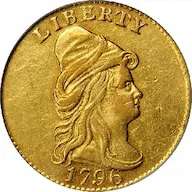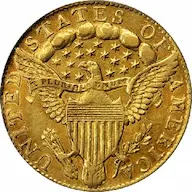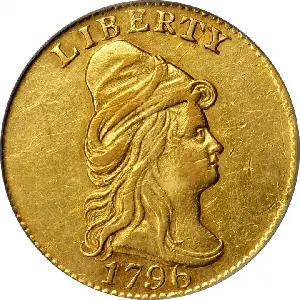1796 Capped Bust $2.50 Quarter Eagle, No Stars
The Mint Act of 1792 marked the beginning of United States coinage. Various denominations of half-cent to $10.00 were specified and to be composed of copper, silver, and gold.(1)
Copper coinage commenced in 1793, but production of silver and gold was delayed because Chief Coiner Henry Voigt and Assayer Albion Cox could not post the $10,000 security bonds required to handle precious metals, an amount almost seven times the annual salaries of these Mint officers.
Congress reduced Voigt’s bond to $,5000 and Cox’s to $1,000. With some help, the sureties were paid, clearing the way for silver coinage production in 1794. Gold coins finally got untracked in 1795.
Of the three gold coins authorized by the 1792 act, the $2.50 quarter eagle was the last to be struck, with the first delivery not occurring until September 1796.(2) Precise records were not kept of the earliest deliveries, but researchers have pieced together evidence to suggest that in 1796, a total of 963 quarter eagles with no obverse stars were produced, followed by another 432 having obverse stars.(3)
There was little demand for quarter eagles in early United States commerce. The denomination was too big for daily business, but too small for bank transactions and international trade, for which $5.00 half eagles were preferred. This explains the miniscule output of quarter eagles. Consider that from 1796 to 1834, a total of just 64,262 of them were issued. Over the same period of time, over 2.1 million half eagles were produced.(4)
The quarter eagles of 1796 to 1807 are described by numismatists as the Capped Bust type, although other names are often invoked. Because the first quarter eagles did not have obverse stars, they constitute a one-year type coin design.(5)
It is not known why the first Capped Bust quarter eagles did not have obverse stars. Several theories have been put forth, including one that suggests the “No Stars” die was incomplete when first used, and that stars were added later in the year to strike the “With Stars” variety. However, careful examination has proven these to be distinctly different dies.
Because of its obvious uniqueness, the 1796 No Stars Capped Bust quarter eagle has been the cat’s meow since United States coin collecting established itself in the fabric of American society. Representatives of the rare one-year type coin began appearing in the high-profile sales of W. Elliot Woodward in the 1860s.(6)
Since then, pressure from design type collectors has fueled consistent price increases for this coin far above those of run-of-the-mill collectible coins. This rarity is a “must have” link in completing a full United States coin type set. The unmistakable historic importance of this coin contributes to its popularity as well.(7)
The “No Stars” obverse die was paired with two reverses to produce the BD-1 and BD-2 die varieties. A vertical die crack ended the life prematurely of the BD-1 reverse. Only a tiny handful of BD-1 survivors exist today, making it the rarest quarter eagle die variety from 1796 to 1834.(8)
The 1796 No Stars Capped Bust quarter eagle is on everyone’s list of classic rarities. It is the first of the long-running quarter eagle denomination and a one-year type of extreme rarity, steeped in American history. It is quite possibly the most desirable gold issue from the 18th century, easily ranking it among the 100 greatest U.S. coins of all time.(9)
| Estimated survivors in all grades: 88 ?
The survivor estimate from PCGS represents an average of one or more experts' opinions as to how many examples survive of a particular coin in all grades. Survival estimates include coins that are raw, certified by PCGS, and certified by other grading services. Learn more at PCGS. |
| PCGS Rarity Scale: 8.1 ?
The 'PCGS CoinFacts Rarity Scale' assesses the relative rarity of all U.S. coins, based on estimated surviving examples. The scale runs from 1.0 to 10.0. The higher the number, the rarer the coin.
Learn more at PCGS. |
| Search for the 1796 Capped Bust $2.50 Quarter Eagle, No Stars on eBay** |
Preview of eBay selection (you'll have to work hard to find one of these early U.S. gold rarities for sale):
 |
 |
| Trendline Avg = 12.71 | CLASSIC RARITY |
 |
 |
| Trendline Avg = 12.71 | CLASSIC RARITY |
Historic Value Trend Charts:
| Last updated 7-8-25 | Return to Key Date Coin List | |
| Compare to Common Date Coin of Same Type | ||
|
|
||
| Download Charts to Your Computer | ||
Sources
1. Taxay, Don. The U.S. Mint and Coinage. New York, NY: Sanford J. Durst Numismatic Publications, 1966.
2. Heritage Auctions. 1796 $2 1/2 No Stars on Obverse, BD-2. Jan 2022 Auction.
3. Heritage Auctions. 1796 $2 1/2 No Stars. BD-2. Jan 2008 Auction.
4. Heritage Auctions. 1796 $2 1/2 No Stars. BD-2. Jan 2008 Auction.
5. Stack's Bowers Galleries. 1796 BD-2. No Stars. Jul 2008 Auction.
6. Heritage Auctions. 1796 $2 1/2 No Stars on Obverse, BD-2. Jan 2022 Auction.
7. Stack's Bowers Galleries. 1796 Capped Bust Quarter Eagle. No Stars. BD-2. May 2015 Auction.
8. Heritage Auctions. 1796 $2 1/2 No Stars on Obverse, BD-2. Jan 2022 Auction.
9. Garrett, Jeff and Guth, Ron. 100 Greatest U.S. Coins, 5th ed. Pelham, AL: Whitman Publishing, 2019.
**Many very fine coin dealers sell on eBay. At any point in time, there may be over one million search results for United States coins. This includes quite a few of the recommendations on our Key Date Coin List.
If you’re thinking about purchasing a rare coin, eBay is certainly worth a look. For your convenience, the links from this site to eBay are coded to bring up only coins certified by PCGS and NGC.
As is always, always the case, never buy a valuable coin from a seller whose trustworthiness cannot be verified. Learn more about this at our chapter Best Places to Buy Coins, which also has a section on doing business on eBay.
In the interest of full disclosure, Rare Coins 101 receives a small commission anytime someone connects to eBay from this site and purchases something.
Coin images by Stack's Bowers Galleries.


